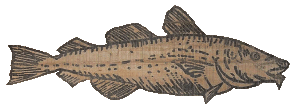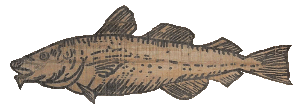Gloucester Harbor


the fishing industry

(click on the image to learn more)
A portion of Gloucester Harbor was captured in this Proctor Brothers photo taken from Rocky Neck. Throughout its history, the harbor has been home to a great deal of activity related to the fishing industry.
No single photo taken from land could capture the full harbor, not even panoramic views.
Many other images of Gloucester harbor, like the one from the NOAA photo library collection, also recorded portions of the harbor. This one from 1882 give a good idea as to just how the various fishing wharves lined the harbor's edge.

The scene of fishing activity aboard a schooner was captured from a Thomas A. Edison movie produced around 1913. This film, entitled "La Industris* de la Pesca en Gloucester Mass USA", may have been created for the Gorton-Pew firm, and was apparently created for a Spanish speaking audience, as all the subtitles are in that language. (*not all of the English terms were translated correctly -- as this was a vintage Edison film, the only way to get another type of copy was to have it videotaped while playing, so apologies for the lower quality level of the video -- approx. 12 min long)
(click on the image to view the film)
(click here for pdf with explanations)

(click on the image to learn more)
The oldest, and one of the best known fish businesses in Gloucester was the firm John Pew & Son, which was established in 1849.
John J. Pew, one of the owners, is standing in the flake yard, which covered several acres. Besides being producers and wholesale dealers, the firm was also an importer and dealer of salt which they brought in bulk from Trapani on the Mediteranian Sea. (above)
Another of the well-known fish firms in Gloucester was Slade Gorton. The firm was founded around 1882, was the first to package salt-dried fish in barrels. (below)
The merger of several companies in 1906, which included the John Pew firm and Slade Gorton, resulted in the firm known as the Gorton-Pew Fisheries Company. By 1907, Shute & Merchant had also merged with Gorton-Pew, which is considered to be the predecessor to what is now Gortons of Gloucester.
(click on the image to learn more)

Upon the merger of the four fish firms -- Slade Gorton & Co., John Pew & Son, D. B. Smith and Reed & Gamage, the Gorton Pew Fisheries Company became the largest fish firm in Gloucester. This merger was a sign of the times, and it wouldn't be long before a number of other long-time Gloucester firms became part of Gorton-Pew. The various plant were located all around Gloucester Harbor, and as can be seen in the image, involved some very large facilities.
By about 1912, this firm owned 15 wharves and 35 buildings in Gloucester. This was in addition to plants in Boston, Maine, Cape Breton and Newfoundland. Their extensive facilities allowed them to put out 375,000 pounds of fish to dry at any one time on the open air flakes. An additional 150,000 poounds could be dried using their indoor spaces.
At this same time, several of the brand names used by the firms prior to the merger continued to be used. Those included the Water Lily brand originally marketed by Slade Gorton & Co., and the Diamond Wedge brand previously sold by Shute & Merchant.


(click on the image to learn more)
Whenever vessels returned to port, the wharves were filled with a variety of men, tools, supplies and activities. At these times, one might find carts, barrels, butts, scales and other pieces of equipment needed to handle the fish. At the end of each voyage hours of work lay ahead. (above)
Fish had to be unloaded before many of the other steps could take place. First, the fish are hoisted out of the schooner's hold and sorted (by size and quality) on the wharf of the firm that had purchased that particular schooner's catch. Often, this step involved buckets being lowered into the hold and, once filled, hoisted up and onto the wharf. (below)
(click on the image to learn more)


(click on the image to learn more)
Once the catch has been unloaded, it is sorted by size and quality, weighed and washed. (above)
The record for unloading and processing a catch of halibut was set in 1879, when it took just eight hours to unload 103,000 pounds of fish. It was in 1917 when an early record catch was recorded. The total of the fish brought to port and unloaded, weighed out for each vessel on Aug. 20, 1917, totaled more that 5,000,000 pounds.
To the left of where the men are standing in this image (below) are part of the scales used for weighing the catch. Another part of the process involved washing the fish to remove the salt it had been salted after it was first caught (in a dory filled with fresh water) and then it would be re-salted. It was also at this point that their tail fins are cut off and their backbones removed.
(click on the image to learn more)


